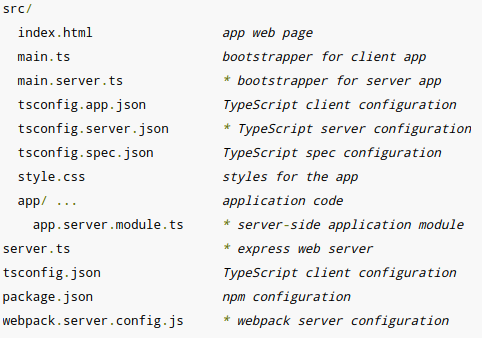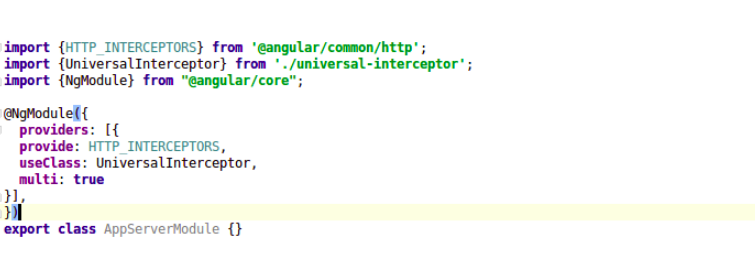Angular Universal: Angular Server-Side Rendering
Angular Universal: Angular Server-Side Rendering
What is server-side rendering angular?
A normal Angular application executes within the browser, rendering pages within the DOM in response to user actions. Angular Universal executes on the server, generating static application pages that later get bootstrapped on the consumer. this implies that the appliance usually renders additional quickly, giving users an opportunity to look at the appliance layout before it becomes totally interactive.
Angular Server-side rendering vs Static Rendering
Angular Server-side rendering isn’t a solution – its dynamic nature will keep company with vital reason overhead prices. several Angular Server-side rendering solutions do not flush early, will delay TTFB or double the info being sent (e.g. inlined state employed by JS on the client). In React, renderToString() is slow as it’s synchronous and single-threaded. obtaining Angular Server-side rendering “right” will involve finding or building an answer for part caching, managing memory consumption, applying memoization techniques, and plenty of different considerations. you are usually processing/rebuilding a similar application multiple times – once on the consumer and once within the server. simply because Angular Server-side rendering will build one thing show up sooner does not suddenly mean you’ve got less work to try to.
Angular Server-side rendering produces hypertext mark-up language on-demand for every address however is slower than simply serving static rendered content. If you’ll be able to place within the extra leg-work, Angular Server-side rendering + hypertext mark-up language caching will massively cut back server render time. The side to Angular Server-side rendering is that the ability to drag additional “live” knowledge and reply to an additional complete set of requests than is feasible with static rendering. Pages requiring personalization square measure a concrete example of the sort of request that may not work well with static rendering.
Angular Server-side rendering may gift fascinating choices once building a PWA. Is it higher to use whole service employee caching, or simply server-render individual items of content?
Universal tutorial
“In this model, the Angular CLI orders and packages the Universal adaptation of the application with the Ahead-of-Time (AoT) compiler.” A Node specific internet server compiles hypertext mark-up language pages with Universal supported consumer requests.
To create the server-side app module, app.server.module.ts, run the subsequent CLI command.
ng add @nguniversal/express-engine --client Project angular-universal
The command creates the subsequent folder structure.


Universal in action
To start rendering your app with Universal on your native system, use the subsequent command.
npm run build:ssr && npm run serve:ssr
Open a browser and navigate to http://localhost:4000/. you must see the acquainted Tour of Heroes dashboard page.
Navigation via routerLinks works properly as a result of they use the native anchor () tags. you’ll be able to go from the Dashboard to the Heroes page and back. you’ll be able to click a hero on the Dashboard page to show its Details page.
If you throttle your network speed in order that the client-side scripts take longer to transfer. User events aside from routerLink clicks are not supported. you want to look ahead to the complete consumer app to bootstrap and run, or buffer the events victimization libraries like preboot, which permit you to replay these events once the client-side scripts load.
The transition from the server-rendered app to the consumer app happens quickly on a development machine, however, you must invariably take a look at your apps in real-world eventualities.
You can simulate a slower network to ascertain the transition additional clearly as follows:
- Open the Chrome Dev Tools and visit the Network tab.
- Find the Network strangling dropdown on the way right of the menu bar.
- Try one in all the “3G” speeds.
The server-rendered app still launches quickly however the complete consumer app might take seconds to load.
Why use server-side rendering?
There square measure 3 main reasons to make a Universal version of your app.
- Facilitate internet crawlers through computer program improvement (SEO)
- Improve performance on mobile and powerless devices
- Show the primary page quickly with a first-contentful paint (FCP)
Facilitate web crawlers (SEO)
Google, Bing, Facebook, Twitter, and different social media sites trust internet crawlers to index your application content and build that content searchable online. These internet crawlers are also unable to navigate and index your extremely interactive Angular application as a personality’s user may do.
Angular Universal will generate a static version of your app that’s simply searchable, linkable, and passable while not JavaScript. Universal additionally makes a website preview on the market since every address returns a totally rendered page.
Improve performance on mobile and powerless devices
Some devices do not support JavaScript or execute JavaScript thus poorly that the user expertise is unacceptable. For these cases, you’ll need a server-rendered, no-JavaScript version of the app. This version, but restricted, is also the sole sensible various for those that otherwise could not use the app in the slightest degree.
Show the primary page quickly
Displaying the primary page quickly is important for user engagement. fifty-three % of mobile website visits square measure abandoned if pages take longer than three seconds to load. Your app might need to launch quicker to interact with these users before they conceive to do one thing else.
With Angular Universal, you’ll be able to generate landing pages for the app that seems like the entire app. The pages square measure pure hypertext mark-up language and might show albeit JavaScript is disabled. The pages do not handle browser events, however, they are doing support navigation through the location victimization router link.
In apply, you will serve a static version of the landing page to carry the user’s attention. At a similar time, you will load the complete Angular app behind it. The user perceives near-instant performance from the landing page and gets the complete interactive expertise once the complete app hundreds.
Universal web servers
A Universal internet server responds to application page requests with static hypertext mark-up language rendered by the Universal model engine. The server receives and responds to hypertext transfer protocol requests from shoppers (usually browsers), and serves static assets like scripts, CSS, and images. it should reply to knowledge requests, either directly or as a proxy to a separate knowledge server.
The sample internet server for this guide is predicated on the popular specific framework.
Universal applications use the Angular platform-server package (as hostile platform-browser), that provides server implementations of the DOM, XMLHttpRequest, and different low-level options that do not trust a browser.
The server (Node-specific during this guide’s example) passes consumer requests for application pages to the NgUniversal, ngExpressEngine. below the hood, this calls Universal’s renderModuleFactory() operate, whereas providing caching and different useful utilities.
The renderModuleFactory() operate takes as inputs a model hypertext mark-up language page (usually index.html), Associate in Nursing Angular module containing parts, and a route that determines that parts to show.
The course originates from the customer’s solicitation to the server. Each request leads to the acceptable read for the requested route. The renderModuleFactory() operate renders the read among the tag of the model, making a finished hypertext mark-up language page for the consumer.
Finally, the server returns the rendered page to the consumer.
Working around the browser APIs
Because a Universal app does not execute within the browser, a number of the browser arthropod genus and capabilities is also missing on the server.
For example, server-side applications cannot reference browser-only international objects like window, document, navigator, or location.
Angular provides some injectable abstractions over these objects, like Location or DOCUMENT; it should substitute adequately for this arthropod genus. If Angular does not offer it, it’s doable to write down new abstractions that delegate to the browser arthropod genus whereas within the browser and to another implementation whereas on the server (aka shimming).
Similarly, while not mouse or keyboard events, a server-side app cannot trust a user clicking a button to indicate a part. The app should confirm what to render based mostly alone on the incoming consumer request. this can be an honest argument for creating the app routable.
Using absolute URLs for server requests
During a Universal app, hypertext transfer protocol URLs should be absolute (for example, https://my-server.com/api/heroes). this implies you wish to alter your services to form requests with absolute URLs once running on the server and with relative URLs once running within the browser.
One solution is to provide the full URL to your application on the server and write an interceptor that can retrieve this value and prepend it to the request URL. If you’re using the ngExpressEngine, as shown in the example in this guide, half the work is already done. We’ll assume this is the case, but it’s trivial to provide the same functionality.
Start by creating an HttpInterceptor:




Universal template engine
The vital bit within the server.ts file is that the ngExpressEngine() operate.


The first parameter is the AppServerModule. it is the bridge between the Universal server-side renderer and also the Angular application.
The second parameter, extra providers, is ex gratia. It enables you to specify dependency suppliers that apply only running on this server. you’ll be able to do that once your app wants info which will solely be determined by the presently running server instance. One example can be the running server’s origin, that can be accustomed calculate absolute hypertext transfer protocol URLs if not victimization the Request token as shown higher than.
The ngExpressEngine() operate returns a Promise request that resolves to the rendered page. It’s up to the engine to come to a decision what to try to therewith page. This engine’s Promise request returns the rendered page to the online server, that then forwards it to the consumer within the hypertext transfer protocol response.
Filtering request URLs:
It’s not as easy as intercepting asking the foundation address /. The browser may invite one in all the appliance routes like /dashboard, /heroes, or /detail:12. In fact, if the app were solely rendered by the server, each app link clicked would attain the server as a navigation address meant for the router.
Fortunately, application routes have one thing in common: their URLs lack file extensions. (Data requests additionally lack extensions however they are simple to acknowledge as a result of they invariably begin with /api.) All static plus requests have a file extension (such as main.js or /node_modules/zone.js/dist/zone.js).
Because we tend to use routing, we are able to simply acknowledge the 3 styles of requests and handle them otherwise.
- Data request: request address that begins /api
- App navigation: request address with no file extension.
- Static asset: all different requests.
A Node-specific server may be a pipeline of middleware that filters and processes request one once the opposite. You tack together the Node-specific server pipeline with calls to app.get() like this one for knowledge requests. 

The following code channels for solicitation URLs without any expansions and treats them as route demands.
Serving static files safely
A single app.use() treats all different URLs as requests for static assets like JavaScript, image, and magnificence files. To ensure that shoppers will solely transfer the files that they’re allowable to ascertain, place all client-facing plus files within the /dist folder and solely honor requests for files from the /dist folder. The following Node-specific code routes all remaining requests to /dist and returns a 404 – NOT FOUND error if the file is not found. 

Read more about the Difference between Angular and React


